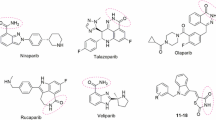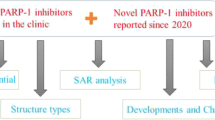Abstract
Selective poly (ADP-ribose) polymerase (PARP)-1 inhibitor represents promising therapy against cancers with a good balance between efficacy and safety. Owing to the conserved structure between PARP-1 and PARP-2, most of the clinical and experimental drugs show equivalent inhibition against both targets. Most recently, it’s disclosed a highly selective PARP-1 inhibitor (NMS-P118) with promising pharmacokinetic properties. Herein, we combined molecular simulation with free energy calculation to gain insights into the selective mechanism of NMS-P118. Our results suggest the reduction of binding affinity for PARP-2 is attributed to the unfavorable conformational change of protein, which is accompanied by a significant energy penalty. Alanine-scanning mutagenesis study further reveals the important role for a tyrosine residue of donor loop (Tyr889PARP-1 and Tyr455PARP-2) in contributing to the ligand selectivity. Retrospective structural analysis indicates the ligand-induced movement of Tyr455PARP-2 disrupts the intra-molecule hydrogen bonding network, which partially accounts for the “high-energy” protein conformation in the presence of NMS-P118. Interestingly, such effect isn’t observed in other non-selective PARP inhibitors including BMN673 and A861695, which validates the computational prediction. Our work provides energetic insight into the subtle variations in the crystal structures and could facilitate rational design of new selective PARP inhibitor.








Similar content being viewed by others
References
Vyas S, Chang P (2014) New PARP targets for cancer therapy. Nat Rev Cancer 14:502–509
Lupo B, Trusolino L (1846) Inhibition of poly(ADP-ribosyl)ation in cancer: old and new paradigms revisited. Biochim Biophys Acta 2014:201–215
Sunderland PT, Woon EC, Dhami A, Bergin AB, Mahon MF, Wood PJ, Jones LA, Tully SR, Lloyd MD, Thompson AS, Javaid H, Martin NM, Threadgill MD (2011) 5-Benzamidoisoquinolin-1-ones and 5-(omega-carboxyalkyl)isoquinolin-1-ones as isoform-selective inhibitors of poly(ADP-ribose) polymerase 2 (PARP-2). J Med Chem 54:2049–2059
Menear KA, Adcock C, Boulter R, Cockcroft XL, Copsey L, Cranston A, Dillon KJ, Drzewiecki J, Garman S, Gomez S, Javaid H, Kerrigan F, Knights C, Lau A, Loh VM Jr, Matthews IT, Moore S, O’Connor MJ, Smith GC, Martin NM (2008) 4-[3-(4-cyclopropanecarbonylpiperazine-1-carbonyl)-4-fluorobenzyl]-2H-phthalazin- 1-one: a novel bioavailable inhibitor of poly(ADP-ribose) polymerase-1. J Med Chem 51:6581–6591
Rottenberg S, Jaspers JE, Kersbergen A, van der Burg E, Nygren AO, Zander SA, Derksen PW, de Bruin M, Zevenhoven J, Lau A, Boulter R, Cranston A, O’Connor MJ, Martin NM, Borst P, Jonkers J (2008) High sensitivity of BRCA1-deficient mammary tumors to the PARP inhibitor AZD2281 alone and in combination with platinum drugs. Proc Natl Acad Sci U S A 105:17079–17084
Donawho CK, Luo Y, Luo Y, Penning TD, Bauch JL, Bouska JJ, Bontcheva-Diaz VD, Cox BF, DeWeese TL, Dillehay LE, Ferguson DC, Ghoreishi-Haack NS, Grimm DR, Guan R, Han EK, Holley-Shanks RR, Hristov B, Idler KB, Jarvis K, Johnson EF, Kleinberg LR, Klinghofer V, Lasko LM, Liu X, Marsh KC, McGonigal TP, Meulbroek JA, Olson AM, Palma JP, Rodriguez LE, Shi Y, Stavropoulos JA, Tsurutani AC, Zhu GD, Rosenberg SH, Giranda VL, Frost DJ (2007) ABT-888, an orally active poly(ADP-ribose) polymerase inhibitor that potentiates DNA-damaging agents in preclinical tumor models. Clin Cancer Res 13:2728–2737
Shen Y, Rehman FL, Feng Y, Boshuizen J, Bajrami I, Elliott R, Wang B, Lord CJ, Post LE, Ashworth A (2013) BMN 673, a novel and highly potent PARP1/2 inhibitor for the treatment of human cancers with DNA repair deficiency. Clin Cancer Res 19:5003–5015
Papeo G, Posteri H, Borghi D, Busel AA, Caprera F, Casale E, Ciomei M, Cirla A, Corti E, D’Anello M, Fasolini M, Forte B, Galvani A, Isacchi A, Khvat A, Krasavin MY, Lupi R, Orsini P, Perego R, Pesenti E, Pezzetta D, Rainoldi S, Riccardi-Sirtori F, Scolaro A, Sola F, Zuccotto F, Felder ER, Donati D, Montagnoli A (2015) Discovery of 2-[1-(4,4-Difluorocyclohexyl)piperidin-4-yl]-6-fluoro-3-oxo-2,3-dihydro-1H-isoind ole-4-carboxamide (NMS-P118): a potent, orally available, and highly selective PARP-1 inhibitor for cancer therapy. J Med Chem 58:6875–6898
Krishnakumar R, Kraus WL (2010) The PARP side of the nucleus: molecular actions, physiological outcomes, and clinical targets. Mol Cell 39:8–24
Yelamos J, Farres J, Llacuna L, Ampurdanes C, Martin-Caballero J (2011) PARP-1 and PARP-2: new players in tumour development. Am J Cancer Res 1:328–346
Yelamos J, Schreiber V, Dantzer F (2008) Toward specific functions of poly(ADP-ribose) polymerase-2. Trends Mol Med 14:169–178
Farres J, Llacuna L, Martin-Caballero J, Martinez C, Lozano JJ, Ampurdanes C, Lopez-Contreras AJ, Florensa L, Navarro J, Ottina E, Dantzer F, Schreiber V, Villunger A, Fernandez-Capetillo O, Yelamos J (2015) PARP-2 sustains erythropoiesis in mice by limiting replicative stress in erythroid progenitors. Cell Death Differ 22:1144–1157
Wahlberg E, Karlberg T, Kouznetsova E, Markova N, Macchiarulo A, Thorsell AG, Pol E, Frostell A, Ekblad T, Oncu D, Kull B, Robertson GM, Pellicciari R, Schuler H, Weigelt J (2012) Family-wide chemical profiling and structural analysis of PARP and tankyrase inhibitors. Nat Biotechnol 30:283–288
Papeo G, Avanzi N, Bettoni S, Leone A, Paolucci M, Perego R, Quartieri F, Riccardi-Sirtori F, Thieffine S, Montagnoli A, Lupi R (2014) Insights into PARP inhibitors’ selectivity using fluorescence polarization and surface plasmon resonance binding assays. J Biomol Screen 19:1212–1219
Ishida J, Yamamoto H, Kido Y, Kamijo K, Murano K, Miyake H, Ohkubo M, Kinoshita T, Warizaya M, Iwashita A, Mihara K, Matsuoka N, Hattori K (2006) Discovery of potent and selective PARP-1 and PARP-2 inhibitors: SBDD analysis via a combination of X-ray structural study and homology modeling. Bioorg Med Chem 14:1378–1390
Hattori K, Kido Y, Yamamoto H, Ishida J, Iwashita A, Mihara K (2007) Rational design of conformationally restricted quinazolinone inhibitors of poly(ADP-ribose)polymerase. Bioorg Med Chem Lett 17:5577–5581
Eltze T, Boer R, Wagner T, Weinbrenner S, McDonald MC, Thiemermann C, Burkle A, Klein T (2008) Imidazoquinolinone, imidazopyridine, and isoquinolindione derivatives as novel and potent inhibitors of the poly(ADP-ribose) polymerase (PARP): a comparison with standard PARP inhibitors. Mol Pharmacol 74:1587–1598
Barillari C, Taylor J, Viner R, Essex JW (2007) Classification of water molecules in protein binding sites. J Am Chem Soc 129:2577–2587
Huang N, Shoichet BK (2008) Exploiting ordered waters in molecular docking. J Med Chem 51:4862–4865
Massova I, Kollman P (2000) Combined molecular mechanical and continuum solvent approach (MM-PBSA/GBSA) to predict ligand binding. Perspect Drug Discov Des 18:113–135
Kollman PA, Massova I, Reyes C, Kuhn B, Huo S, Chong L, Lee M, Lee T, Duan Y, Wang W, Donini O, Cieplak P, Srinivasan J, Case DA, Cheatham TE 3rd (2000) Calculating structures and free energies of complex molecules: combining molecular mechanics and continuum models. Acc Chem Res 33:889–897
Lefevre F, Remy MH, Masson JM (1997) Alanine-stretch scanning mutagenesis: a simple and efficient method to probe protein structure and function. Nucleic Acids Res 25:447–448
Massova I, Kollman PA (1999) Computational alanine scanning to probe protein-protein interactions: a novel approach to evaluate binding free energies. J Am Chem Soc 121:8133–8143
Jacobson MP, Kaminski GA, Friesner RA, Rapp CS (2002) Force field validation using protein side chain prediction. J Phys Chem B 106:11673–11680
Jacobson MP, Pincus DL, Rapp CS, Day TJ, Honig B, Shaw DE, Friesner RA (2004) A hierarchical approach to all-atom protein loop prediction. Proteins 55:351–367
Li X, Jacobson MP, Friesner RA (2004) High-resolution prediction of protein helix positions and orientations. Proteins 55:368–382
Cao R, Liu M, Yin M, Liu Q, Wang Y, Huang N (2012) Discovery of novel tubulin inhibitors via structure-based hierarchical virtual screening. J Chem Inf Model 52:2730–2740
Cao R, Huang N, Wang Y (2014) Evaluation and application of MD-PB/SA in structure-based hierarchical virtual screening. J Chem Inf Model 54:1987–1996
Cao R, Wang Y (2015) Predicting molecular targets for small-molecule drugs with a ligand-based interaction fingerprint approach. Chem Med Chem
Jorgensen WL, Maxwell DS, Tirado-Rives J (1996) Development and testing of the OPLS all-atom force field on conformational energetics and properties of organic liquids. J Am Chem Soc 118:11225–11236
Kaminski GA, Friesner RA, Tirado-Rives J, Jorgensen WL (2001) Evaluation and reparametrization of the OPLS-AA force field for proteins via comparison with accurate quantum chemical calculations on peptides? J Phys Chem B 105:6474–6487
Pettersen EF, Goddard TD, Huang CC, Couch GS, Greenblatt DM, Meng EC, Ferrin TE (2004) UCSF Chimera—a visualization system for exploratory research and analysis. J Comput Chem 25:1605–1612
Author information
Authors and Affiliations
Corresponding author
Rights and permissions
About this article
Cite this article
Cao, R. Free energy calculation provides insight into the action mechanism of selective PARP-1 inhibitor. J Mol Model 22, 74 (2016). https://doi.org/10.1007/s00894-016-2952-x
Received:
Accepted:
Published:
DOI: https://doi.org/10.1007/s00894-016-2952-x




